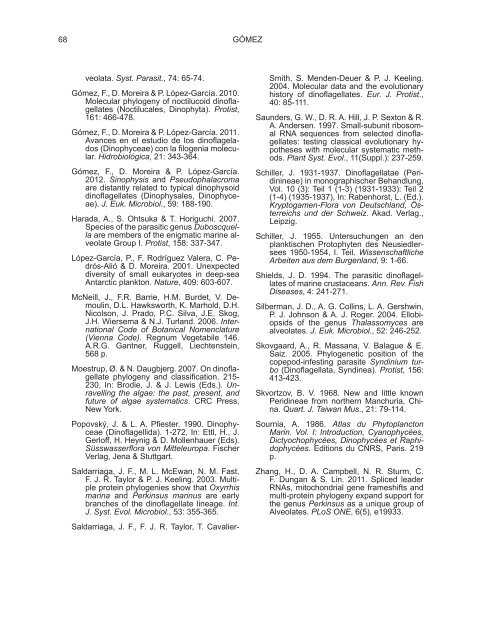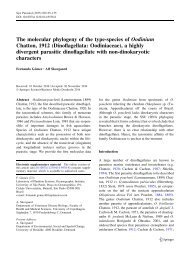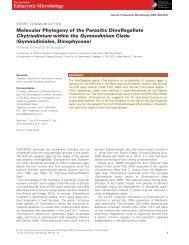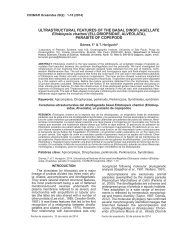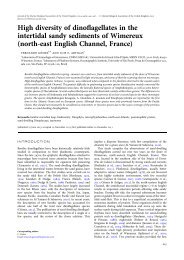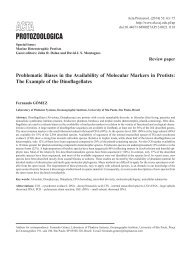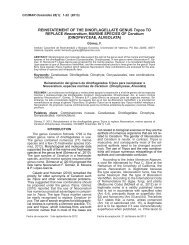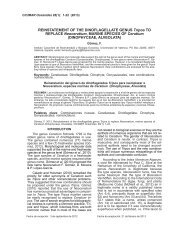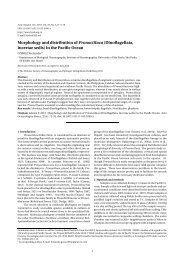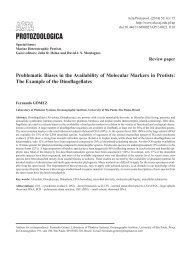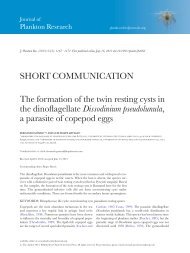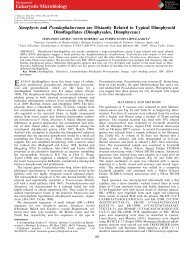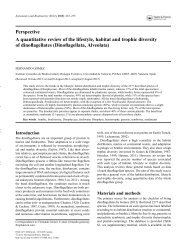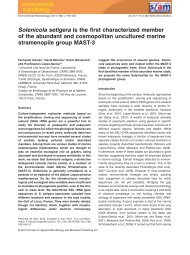A CHECKLIST AND CLASSIFICATION OF LIVING DINOFLAGELLATES (DINOFLAGELLATA, ALVEOLATA)
A checklist and classification of the extant dinoflagellates are given. Dinokaryotic dinoflagellates (including Noctilucales) comprised 2,294 species belonging to 238 genera. Dinoflagellates sensu lato (Ellobiopsea, Oxyrrhea, Syndinea and Dinokaryota) comprised 2,377 species belonging to 259 genera. The nomenclature of several taxa has been corrected according to the International Code of Botanical Nomenclature. When gene sequences were available, the species were classified following the Small and Large SubUnit rDNA (SSU and LSU rDNA) phylogenies. No taxonomical innovations are proposed herein. However, the checklist revealed that taxa distantly related to the type species of their genera would need to be placed in a new or another known genus. At present, the most extended molecular markers are unable to elucidate the interrelations between the classical orders, and the available sequences of other markers are still insufficient. The classification of the dinoflagellates remains unresolved, especially at the order level.
A checklist and classification of the extant dinoflagellates are given. Dinokaryotic dinoflagellates (including Noctilucales) comprised 2,294 species belonging to 238 genera. Dinoflagellates sensu lato (Ellobiopsea, Oxyrrhea, Syndinea and Dinokaryota) comprised 2,377 species belonging to 259 genera. The nomenclature of several taxa has been corrected according to the International Code of Botanical Nomenclature. When gene sequences were available, the species were classified following the Small and Large SubUnit rDNA (SSU and LSU rDNA) phylogenies. No taxonomical innovations are proposed herein. However, the checklist revealed that taxa distantly related to the type species of their genera would need to be placed in a new or another known genus. At present, the most extended molecular markers are unable to elucidate the interrelations between the classical orders, and the available sequences of other markers are still insufficient. The classification of the dinoflagellates remains unresolved, especially at the order level.
Create successful ePaper yourself
Turn your PDF publications into a flip-book with our unique Google optimized e-Paper software.
68 GÓMEZ<br />
veolata. Syst. Parasit., 74: 65-74.<br />
Gómez, F., D. Moreira & P. López-García. 2010.<br />
Molecular phylogeny of noctilucoid dinoflagellates<br />
(Noctilucales, Dinophyta). Protist,<br />
161: 466-478.<br />
Gómez, F., D. Moreira & P. López-García. 2011.<br />
Avances en el estudio de los dinoflagelados<br />
(Dinophyceae) con la filogenia molecular.<br />
Hidrobiológica, 21: 343-364.<br />
Gómez, F., D. Moreira & P. López-García.<br />
2012. Sinophysis and Pseudophalacroma<br />
are distantly related to typical dinophysoid<br />
dinoflagellates (Dinophysales, Dinophyceae).<br />
J. Euk. Microbiol., 59: 188-190.<br />
Harada, A., S. Ohtsuka & T. Horiguchi. 2007.<br />
Species of the parasitic genus Duboscquella<br />
are members of the enigmatic marine alveolate<br />
Group I. Protist, 158: 337-347.<br />
López-García, P., F. Rodríguez Valera, C. Pedrós-Alió<br />
& D. Moreira. 2001. Unexpected<br />
diversity of small eukaryotes in deep-sea<br />
Antarctic plankton. Nature, 409: 603-607.<br />
McNeill, J., F.R. Barrie, H.M. Burdet, V. Demoulin,<br />
D.L. Hawksworth, K. Marhold, D.H.<br />
Nicolson, J. Prado, P.C. Silva, J.E. Skog,<br />
J.H. Wiersema & N.J. Turland. 2006. International<br />
Code of Botanical Nomenclature<br />
(Vienna Code). Regnum Vegetabile 146.<br />
A.R.G. Gantner, Ruggell, Liechtenstein,<br />
568 p.<br />
Moestrup, Ø. & N. Daugbjerg. 2007. On dinoflagellate<br />
phylogeny and classification. 215-<br />
230, In: Brodie, J. & J. Lewis (Eds.). Unravelling<br />
the algae: the past, present, and<br />
future of algae systematics. CRC Press,<br />
New York.<br />
Popovský, J. & L. A. Pfiester. 1990. Dinophyceae<br />
(Dinoflagellida). 1-272, In: Ettl, H., J.<br />
Gerloff, H. Heynig & D. Mollenhauer (Eds).<br />
Süsswasserflora von Mitteleuropa. Fischer<br />
Verlag, Jena & Stuttgart.<br />
Saldarriaga, J. F., M. L. McEwan, N. M. Fast,<br />
F. J. R. Taylor & P. J. Keeling. 2003. Multiple<br />
protein phylogenies show that Oxyrrhis<br />
marina and Perkinsus marinus are early<br />
branches of the dinoflagellate lineage. Int.<br />
J. Syst. Evol. Microbiol., 53: 355-365.<br />
Saldarriaga, J. F., F. J. R. Taylor, T. Cavalier-<br />
Smith, S. Menden-Deuer & P. J. Keeling.<br />
2004. Molecular data and the evolutionary<br />
history of dinoflagellates. Eur. J. Protist.,<br />
40: 85-111.<br />
Saunders, G. W., D. R. A. Hill, J. P. Sexton & R.<br />
A. Andersen. 1997. Small-subunit ribosomal<br />
RNA sequences from selected dinoflagellates:<br />
testing classical evolutionary hypotheses<br />
with molecular systematic methods.<br />
Plant Syst. Evol., 11(Suppl.): 237-259.<br />
Schiller, J. 1931-1937. Dinoflagellatae (Peridinineae)<br />
in monographischer Behandlung,<br />
Vol. 10 (3): Teil 1 (1-3) (1931-1933): Teil 2<br />
(1-4) (1935-1937), In: Rabenhorst, L. (Ed.).<br />
Kryptogamen-Flora von Deutschland, Österreichs<br />
und der Schweiz. Akad. Verlag.,<br />
Leipzig.<br />
Schiller, J. 1955. Untersuchungen an den<br />
planktischen Protophyten des Neusiedlersees<br />
1950-1954, I. Teil. Wissenschaftliche<br />
Arbeiten aus dem Burgenland, 9: 1-66.<br />
Shields, J. D. 1994. The parasitic dinoflagellates<br />
of marine crustaceans. Ann. Rev. Fish<br />
Diseases, 4: 241-271.<br />
Silberman, J. D., A. G. Collins, L. A. Gershwin,<br />
P. J. Johnson & A. J. Roger. 2004. Ellobiopsids<br />
of the genus Thalassomyces are<br />
alveolates. J. Euk. Microbiol., 52: 246-252.<br />
Skovgaard, A., R. Massana, V. Balague & E.<br />
Saiz. 2005. Phylogenetic position of the<br />
copepod-infesting parasite Syndinium turbo<br />
(Dinoflagellata, Syndinea). Protist, 156:<br />
413-423.<br />
Skvortzov, B. V. 1968. New and little known<br />
Peridineae from northern Manchuria, China.<br />
Quart. J. Taiwan Mus., 21: 79-114.<br />
Sournia, A. 1986. Atlas du Phytoplancton<br />
Marin. Vol. I: Introduction, Cyanophycées,<br />
Dictyochophycées, Dinophycées et Raphidophycées.<br />
Editions du CNRS, Paris. 219<br />
p.<br />
Zhang, H., D. A. Campbell, N. R. Sturm, C.<br />
F. Dungan & S. Lin. 2011. Spliced leader<br />
RNAs, mitochondrial gene frameshifts and<br />
multi-protein phylogeny expand support for<br />
the genus Perkinsus as a unique group of<br />
Alveolates. PLoS ONE, 6(5), e19933.


